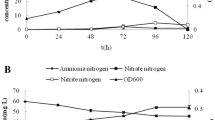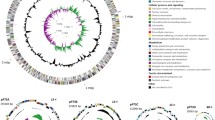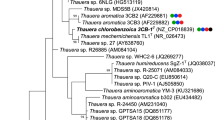Abstract
The novel carbazole (CAR)-degrading bacterium Lysobacter sp. strain OC7 has been isolated from seawater and can also utilize naphthalene and phenanthrene as its sole carbon and energy source. The CAR-degradative gene cluster was isolated and encoded five complete open reading frames (ORFs) and two truncated ORFs. Among them, four ORFs showed 40–50% similarity with previously reported CAR-degradative genes. Ferredoxin (carAc) and ferredoxin reductase (carAd) genes, which are necessary for the CAR 1,9a-dioxygenase system, were not found in this car gene cluster. The car OC7 gene transcripts were strongly detected when CAR was provided. However, these transcripts were also detected when naphthalene was provided. The resting cell reaction with Escherichia coli revealed that CarAaOC7 can use CarAc and CarAd of Pseudomonas resinovorans CA10 as ferredoxin and ferredoxin reductase, respectively, and converted CAR to 2′-aminobiphenyl-2,3-diol. In 13 marine CAR-degrading isolates, only Caulobacter sp. strain OC6 hybridized with the car OC7 gene cluster probe. This is the first report showing CAR-degradative genes from the genus Lysobacter.



Similar content being viewed by others
References
Dyksterhouse SE, Gray JP, Herwig RP, Lara JC, Staley JT (1995) Cycloclasticus pugetii gen. nov., sp. nov., an aromatic hydrocarbon-degrading bacterium from marine sediments. Int J Syst Bacteriol 45:116–123
Evans PJ, Mang DT, Young LY (1991) Degradation of toluene and m-xylene and transformation of o-xylene by denitrifying enrichment cultures. Appl Environ Microbiol 57:450–454
Fuse H, Takimura O, Murakami K, Inoue H, Yamaoka Y (2003) Degradation of chlorinated biphenyl, dibenzofuran, and dibenzo-p-dioxin by marine bacteria that degrade biphenyl, carbazole, or dibenzofuran. Biosci Biotechnol Biochem 67:1121–1125
Habe H, Ashikawa Y, Saiki Y, Yoshida T, Nojiri H, Omori T (2002) Sphingomonas sp. strain KA1, carrying a carbazole dioxygenase gene homologue, degrades chlorinated dibenzo-p-dioxins in soil. FEMS Microbiol Lett 211:43–49
Inoue K, Habe H, Ymane H, Nojiri H (2006) Characterization of novel carbazole catabolism genes from Gram-positive carbazole degrader Nocardioides aromaticivorans IC177. Appl Environ Microbiol 72:3321–3329
Inoue K, Habe H, Yamane H, Omori T, Nojiri H (2005) Diversity of carbazole-degrading bacteria having the car gene cluster: isolation of a novel Gram-positive carbazole-degrading bacterium. FEMS Microbiol Lett 245:145–153
Maeda R, Nagashima H, Widada J, Iwata K, Omori T (2009) Novel marine carbazole-degrading bacteria. FEMS Microbiol Lett 292:203–209
Mason JR, Cammack R (1992) The electron-transport proteins of hydroxylating bacterial dioxygenases. Annu Rev Microbiol 46:277–305
Nam JW, Nojiri H, Noguchi H, Uchimura H, Yoshida T, Habe H, Yamane H, Omori T (2002) Purification and characterization of carbazole 1, 9a-dioxygenase, a three-component dioxygenase system Pseudomonas resinovorans strain CA10. Appl Environ Microbiol 68:45882–45890
Nojiri H, Ashikawa Y, Noguchi H, Nam JW, Urata M, Fujimoto Z, Uchimura H, Terada T, Nakamura S, Shimizu K, Yoshida T, Habe H, Omori T (2005) Structure of the terminal oxygenase component of angular dioxygenase, carbazole1, 9a-dioxygenase. J Mol Biol 351:355–370
Nojiri H, Nam JW, Kosaka M, Morii K, Takemura T, Furihata K, Yamane H, Omori T (1999) Diverse oxygenations catalyzed by carbazole 1, 9a-dioxygenase from Pseudomonas sp. strain CA10. J Bacteriol 181:3105–3113
Nojiri H, Shintani M, Omori T (2004) Divergence of mobile genetic elements involved in the distribution of xenobiotic-catabolic capacity. Appl Microbiol Biotechnol 64:154–174
Ouchiyama N, Zhang Y, Omori T, Kodama T (1993) Biodegradation of carbazole by Pseudomonas spp. CA06 and CA10. Biosci Biotechnol Biochem 57:455–460
Sambrook J, Russell DW (2001) Molecular cloning: a laboratory manual, 3rd edn. Cold Spring Harbor Laboratory Press, Cold Spring Harbor, NY
Sato S, Nam JW, Kasuga K, Nojiri H, Yamane H, Omori T (1997) Identification and characterization of genes encoding carbazole 1, 9a-dioxygenase in Pseudomonas sp. strain CA10. J Bacteriol 179:4850–4858
Sato S, Ouchiyama N, Kimura T, Nojiri H, Yamane H, Omori T (1997) Cloning of genes involved in carbazole degradation of Pseudomonas sp. strain CA10: nucleotide sequences of genes and characterization of meta-cleavage enzymes and hydrolase. J Bacteriol 179:4841–4849
Shine J, Dalgarno L (1975) Determination of cistron specificity in bacterial ribosomes. Nature 254:34–38
Takagi T, Nojiri H, Yoshida T, Habe H, Omori T (2002) Detailed comparison between the substrate specificities of two angular dioxygenases, dibenzofuran 4, 4a-dioxygenase from Terrabacter sp. and carbazole 1, 9a-dioxygenase from Pseudomonas resinovorans. Biotechnol Lett 24:2099–2106
Urata M, Miyakoshi M, Kai S, Maeda K, Habe H, Omori T, Yamane H, Nojiri H (2004) Transcriptional regulation of the ant operon, encoding two-component anthranilate 1,2-dioxygenase, on the carbazole-degradative plasmid pCAR1 of Pseudomonas resinovorans strain CA10. J Bacteriol 186:6815–6823
Urata M, Uchimura H, Noguchi H, Sakaguchi T, Takemura T, Eto K, Habe H, Omori T, Yamane H, Nojiri H (2006) Plasmid pCAR3 contains multiple gene sets involved in the conversion of carbazole to anthranilate. Appl Environ Microbiol 72:3206–3216
Yoon BJ, Lee DH, Kang YS, Oh DC, Kim SI, Oh KH, Kahng HY (2002) Evaluation of carbazole degradation by Pseudomonas rhodesiae strain KK1 isolated from soil contaminated with coal tar. J Basic Microbiol 42:434–443
Acknowledgment
This research was supported by a Grant-in-Aid for Scientific Research (17380056 to T.O.) from the Ministry of Education, Culture, Sports, Science, and Technology of Japan.
Author information
Authors and Affiliations
Corresponding author
Electronic supplementary material
Below is the link to the electronic supplementary material.
Rights and permissions
About this article
Cite this article
Maeda, R., Nagashima, H., Zulkharnain, A.B. et al. Isolation and Characterization of a car Gene Cluster from the Naphthalene, Phenanthrene, and Carbazole-Degrading Marine Isolate Lysobacter sp. Strain OC7. Curr Microbiol 59, 154–159 (2009). https://doi.org/10.1007/s00284-009-9414-y
Received:
Revised:
Accepted:
Published:
Issue Date:
DOI: https://doi.org/10.1007/s00284-009-9414-y




